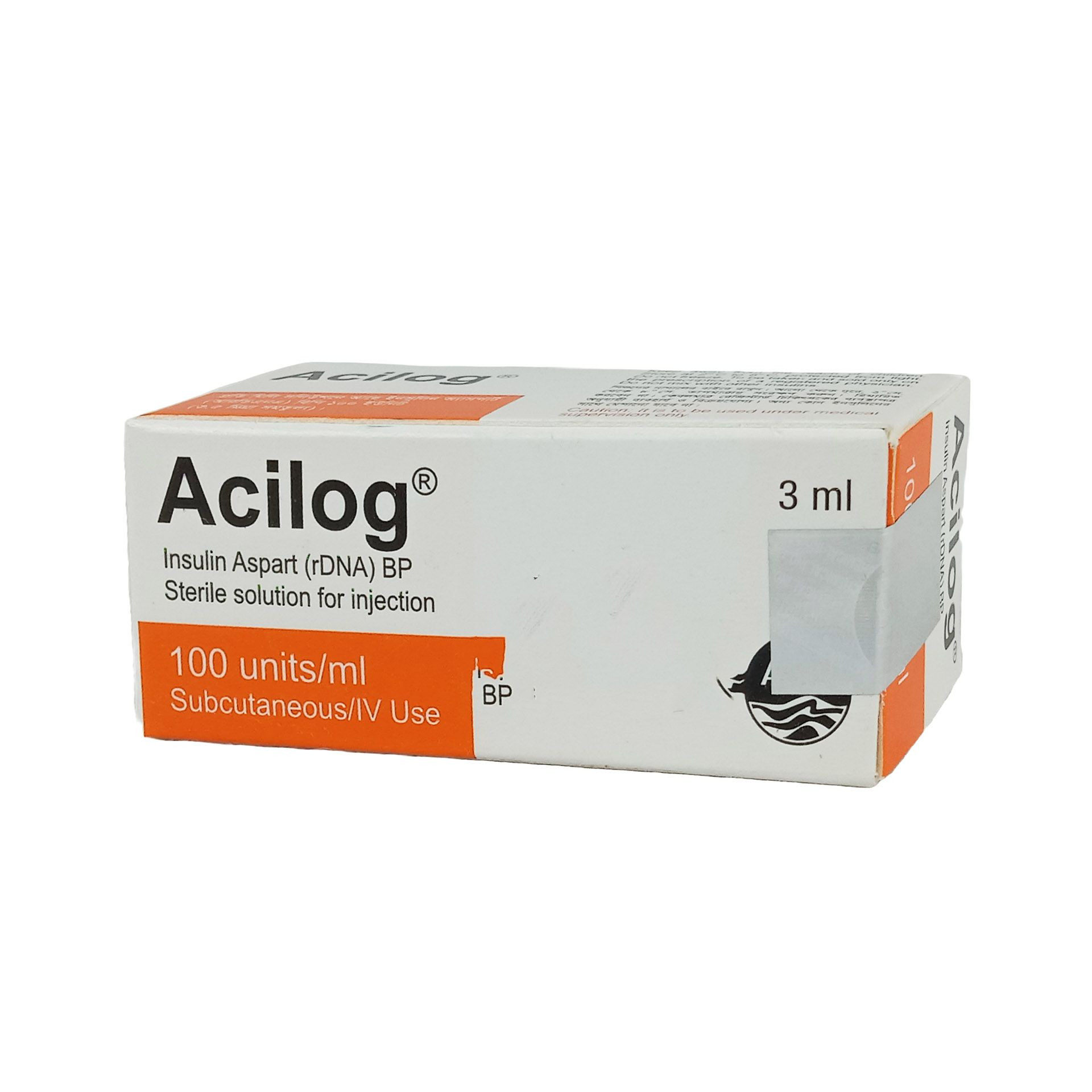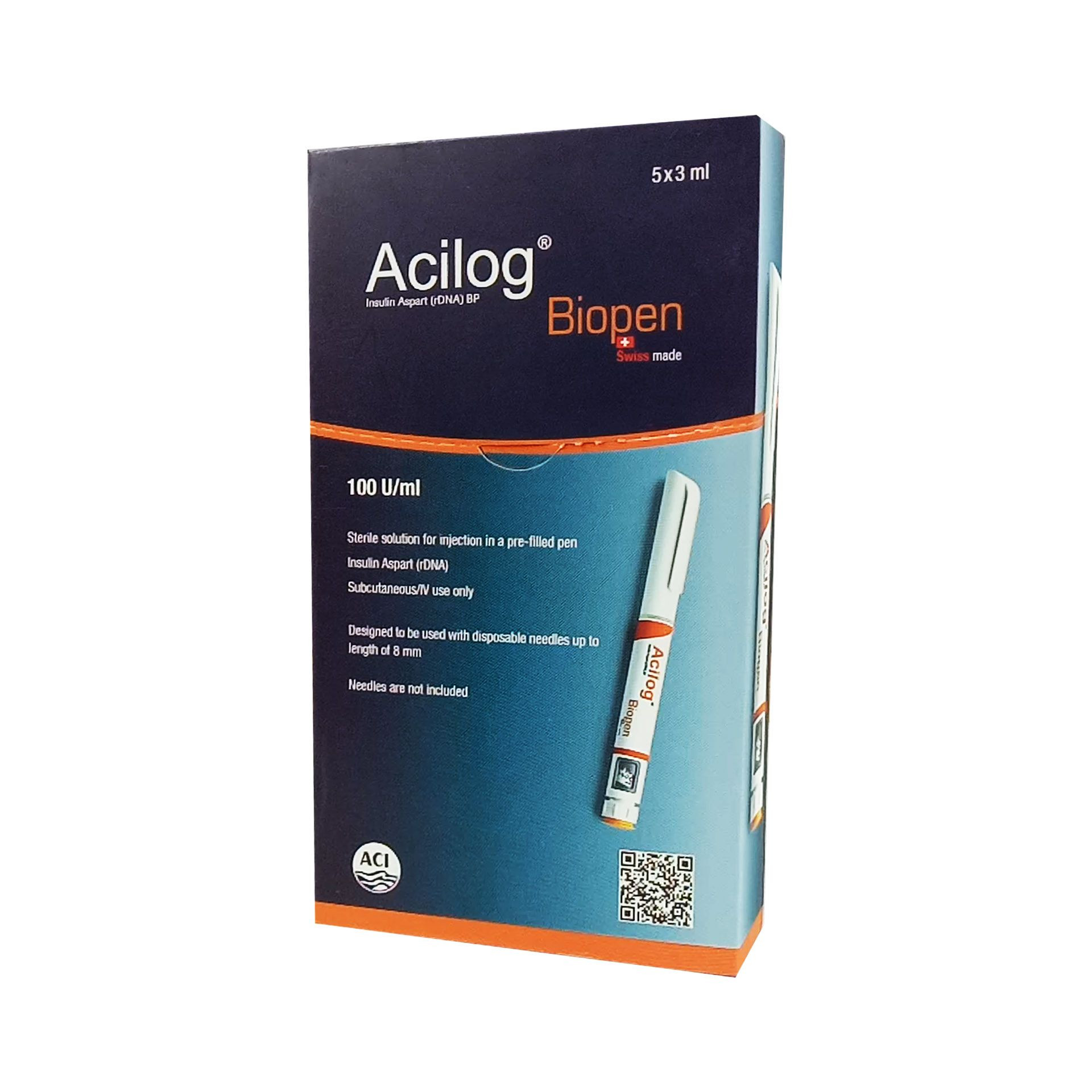3 ml BioPen:
৳ 825.00
(5's pack: ৳ 4,125.00)
3 ml cartridge:
৳ 550.00
(3's pack: ৳ 1,650.00)
3 ml vial:
৳ 450.00
Indications
Acilog SC Injection is an insulin analog indicated to improve glycemic control in patients with diabetes mellitus.
* রেজিস্টার্ড চিকিৎসকের পরামর্শ মোতাবেক ঔষধ সেবন করুন
Composition
Each ml solution contains 100 IU (equivalent to 3.50 mg) Insulin Aspart (rDNA).
Description
Acilog rDNA is a sterile, clear solution of Acilog human insulin analogue for subcutaneous injection/infusion or intravenous injection. This is a blood glucose lowering agent with an earlier onset of action. It produces a more rapid onset of action compared to soluble human insulin. Acilog is homologous with regular human insulin with the exception of a single substitution of the amino acid Proline by aspartic acid in position B28, and is produced by recombinant DNA technology.
Pharmacology
The primary activity of Insulin Aspart is the regulation of glucose metabolism. Insulin Aspart bind to the insulin receptors on muscle and fat cells and lower blood glucose by facilitating the cellular uptake of glucose and simultaneously inhibiting the output of glucose from the liver.
Dosage
Insulin Aspart has a faster onset and a shorter duration of action than soluble human insulin. Due to the faster onset of action, Insulin Aspart should generally be given immediately before a meal. When necessary Insulin Aspart may be given soon after a meal.
Dosage of Insulin Aspart is individual and determined on the basis of the physician's advice in accordance with the needs of the patient. It should normally be used in combination with long-acting insulin given at least once a day.
The individual insulin requirement is usually between 0.5 and 1.0 IU/kg/day in adults and children over 2 years of age. In a meal-related treatment 50-70% of this requirement may be provided by Insulin Aspart and the remainder by long-acting insulin. Adjustment of dosage may also be necessary if patients undertake increased physical activity or change their usual diet. Exercise taken immediately after a meal may increase the risk of hypoglycaemia.
Subcutaneous Injection: Insulin Aspart should be administered by subcutaneous injection in the abdominal region, buttocks, thigh, or upper arm. Because Insulin Aspart has a more rapid onset and a shorter duration of activity than human regular insulin, it should be injected immediately (within 5-10 minutes) before a meal Continuous Subcutaneous Insulin Infusion (CSII) by External Pump Insulin Aspart can also be infused subcutaneously by an external insulin pump. The initial programming of the external insulin infusion pump should be based on the total daily insulin dose of the previous regimen. Approximately 50% of the total dose is usually given as meal-related boluses of Insulin Aspart and the remainder is given as a basal infusion. When used with an infusion pump Insulin Aspart should not be mixed with any other insulin.
Intravenous Use: Insulin Aspart can be administered intravenously under medical supervision for glycemic control with close monitoring of blood glucose and potassium levels to avoid hypoglycemia and hypokalemia. For intravenous use, Insulin Aspart should be used at concentrations from 0.05 IU/mL to 1.0 IU/mL insulin aspart in infusion systems using polypropylene infusion bags. Insulin Aspart has been shown to be stable in infusion fluids such as 0.9% sodium chloride.
Dosage of Insulin Aspart is individual and determined on the basis of the physician's advice in accordance with the needs of the patient. It should normally be used in combination with long-acting insulin given at least once a day.
The individual insulin requirement is usually between 0.5 and 1.0 IU/kg/day in adults and children over 2 years of age. In a meal-related treatment 50-70% of this requirement may be provided by Insulin Aspart and the remainder by long-acting insulin. Adjustment of dosage may also be necessary if patients undertake increased physical activity or change their usual diet. Exercise taken immediately after a meal may increase the risk of hypoglycaemia.
Subcutaneous Injection: Insulin Aspart should be administered by subcutaneous injection in the abdominal region, buttocks, thigh, or upper arm. Because Insulin Aspart has a more rapid onset and a shorter duration of activity than human regular insulin, it should be injected immediately (within 5-10 minutes) before a meal Continuous Subcutaneous Insulin Infusion (CSII) by External Pump Insulin Aspart can also be infused subcutaneously by an external insulin pump. The initial programming of the external insulin infusion pump should be based on the total daily insulin dose of the previous regimen. Approximately 50% of the total dose is usually given as meal-related boluses of Insulin Aspart and the remainder is given as a basal infusion. When used with an infusion pump Insulin Aspart should not be mixed with any other insulin.
Intravenous Use: Insulin Aspart can be administered intravenously under medical supervision for glycemic control with close monitoring of blood glucose and potassium levels to avoid hypoglycemia and hypokalemia. For intravenous use, Insulin Aspart should be used at concentrations from 0.05 IU/mL to 1.0 IU/mL insulin aspart in infusion systems using polypropylene infusion bags. Insulin Aspart has been shown to be stable in infusion fluids such as 0.9% sodium chloride.
* রেজিস্টার্ড চিকিৎসকের পরামর্শ মোতাবেক ঔষধ সেবন করুন
Administration
Instructions to be given to the patient before injecting this Insulin:
- According to the instruction given with ConviPen, insert the cartridge into the pen correctly & equip the needle
- Gently turn the pen upside down for 8-10 times until the insulin in the cartridge becomes uniformly mixed suspension
- Remove the needle cap, discharge air bubbles in the catridge
- Adjust the dosage button to get correct dose & inject to the specific site
- In order to avoid cross contamination, do not let the needle touch anything during the process of preparation.
* রেজিস্টার্ড চিকিৎসকের পরামর্শ মোতাবেক ঔষধ সেবন করুন
Interaction
A number of drugs affect glucose metabolism and may require dose adjustment.
The following substances may reduce the Acilog as well as Acilog requirements: Oral anti-diabetic products, angiotensin converting enzyme (ACE) inhibitors, disopyramide, fibrates, fluoxetine, monoamine oxidase inhibitors, propoxyphene, pentoxifylline, salicylates and sulfonamide antibiotics.
The following substances may increase the Acilog as well as Acilog requirements: Thiazides, glucocorticoids, thyroid hormones, beta-sympathomimetics, growth hormone and danazol. Beta-blockers, clonidine, lithium salts, and alcohol may either potentiate or weaken the blood glucose lowering effect of insulin.
The following substances may reduce the Acilog as well as Acilog requirements: Oral anti-diabetic products, angiotensin converting enzyme (ACE) inhibitors, disopyramide, fibrates, fluoxetine, monoamine oxidase inhibitors, propoxyphene, pentoxifylline, salicylates and sulfonamide antibiotics.
The following substances may increase the Acilog as well as Acilog requirements: Thiazides, glucocorticoids, thyroid hormones, beta-sympathomimetics, growth hormone and danazol. Beta-blockers, clonidine, lithium salts, and alcohol may either potentiate or weaken the blood glucose lowering effect of insulin.
Side Effects
Side effects of Acilog are hypoglycemia, allergic reactions, injection site reaction, lipodystrophy, pruritus and rash.
Pregnancy & Lactation
Pregnancy category B. There are no restrictions on treatment with Protamine Crystallised Insulin Aspart during lactation. Insulin treatment of the nursing mother should not affect the baby. However, dosage may need to be adjusted.
Precautions & Warnings
Dose adjustment and monitoring: Blood glucose should be monitored in all patients treated with insulin. Acilog regimens should be modified cautiously and only under medical supervision
Overdose Effects
A specific overdose for insulin cannot be defined, however, hypoglycaemia may develop over sequential stages if too high doses relative to the patient’s requirement are administered. Mild hypoglycaemic episodes can be treated by oral administration of glucose or sugary products. Severe hypoglycaemic episodes, where the patient has become unconscious, can be treated by glucagon (0.5 to 1 mg) given intramuscularly or subcutaneously. Glucose must also be given intravenously if the patient does not respond to glucagon within 10 to 15 minutes. Upon regaining consciousness administration of oral carbohydrate is recommended for the patient in order to prevent relapse.
Therapeutic Class
Rapid Acting Insulin
Storage Conditions
Store at 2°C to 8°C in a refrigerator. Do not freeze. Protect from light.
Pack Images: Acilog 100 IU Injection


